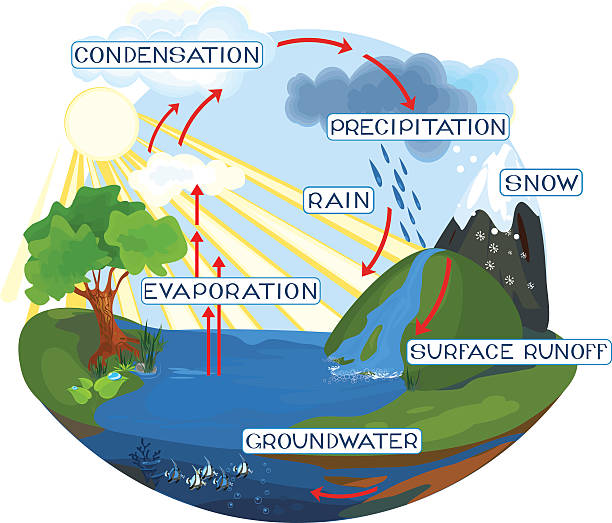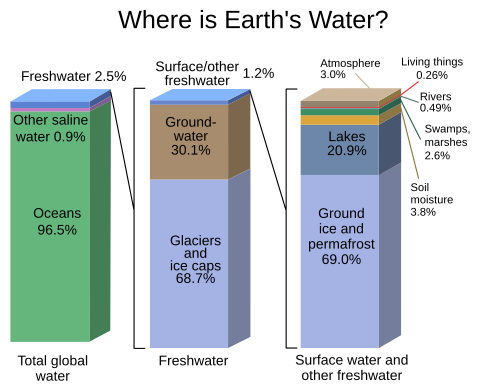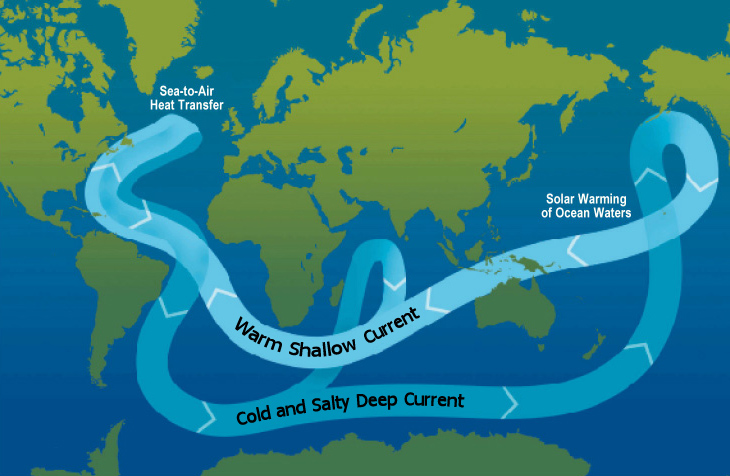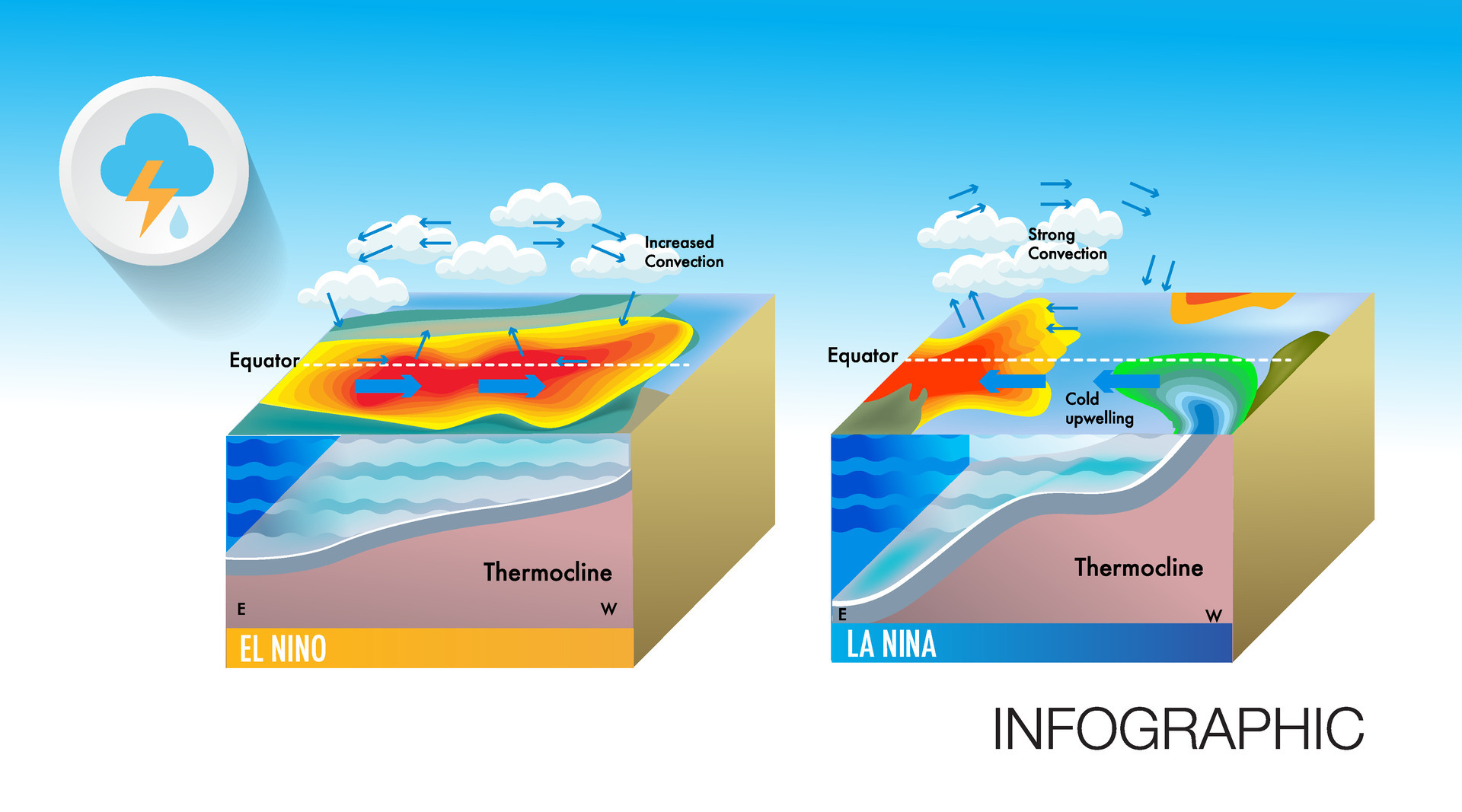IB Environmental Systems and Societies (HL) - Topic 4: Water
IB Environmental Systems and Societies (HL) - Topic 4: Water
4.1 - Water Systems
- Hydrological cycle (The Water Cycle): Interconnected system where water moves through the atmosphere while going through different phases
- Water moves into storages and flows throughout the cycle
- Storages: Where water is stored when it is not actively moving through the water cycle. The time spent in storages greatly varies.
- Examples of storages:
- Organisms
- Soil
- Oceans
- Water vapor/the atmosphere
- Surface waters
- Ice caps/glaciers
- Aquifers
- Examples of storages:
- Flows: When water moves from one storage to another via flow routes. Can either be transformations (change in state) or transfers (change in location)
- Examples of flow transformations:
- Evaporation
- Liquid water becomes gas after being heated, and removes salt and other metals/minerals
- Transpiration
- Process where plants absorb water through roots and release water vapor through the stomata in their leaves
- Evapotranspiration
- Combined process of both evaporation and transpiration
- Condensation
- Gas water becomes liquid again because it has cooled, which forms clouds or dew
- Sublimation
- When water directly becomes gas, after being a solid, without going through a liquid state first
- Freezing/melting
- Evaporation
- Examples of flow transfers:
- Advection
- When water vapor/droplets/clouds are moved by the wind
- Flooding
- Precipitation
- Surface run-off
- Infiltration
- When water from the surface seeps through the soil layers and becomes groundwater
- Percolation
- When water moves downwards through soil/rocks after infiltration, eventually reaching groundwater reservoirs
- Groundwater flow
- Current/stream flow
- Absorption
- Advection
- Examples of flow transformations:
- Water cycle is driven by energy from the sun
- In its most basic form, the cycle follows three steps:
1. The sun’s heat will evaporate the water in storages (ex. Lakes, oceans)
2. The water vapor cools and condenses, and then falls back to the Earth as precipitation (ex. Rain, snow)
3. Runoff from the precipitation will eventually find its way back to storages

- Freshwater only makes up 2.5% of the Earth’s water
- In some storages (such as groundwater), water would be considered non-renewable because it is renewed too slow

- Human impacts on the Water Cycle:
- Surface runoff and infiltration can be impacted by human activities, such as
- Agriculture:
- Disruption of soil and usage of pesticides/fertilizers can cause contaminated runoff/groundwater
- Deforestation:
- The lack of trees causes more soil erosion and nearby water contamination because there are no trees to filter the runoff
- Decreases transpiration, which reduces moisture in the air
- Burning fossil fuel:
- Increased temperatures cause more evaporation/melting, which alters the natural balance of the cycle
- Agriculture:
- Ocean circulation system
- Ocean conveyor belt:
- Constantly moving system that moves water around, driven by differences in salinity and temperature
- Results in the movement of nutrients and heat, which is essential for regulating local weather and global climate, and for the health of marine ecosystems

- El Niño: Climate pattern where the surface waters of the eastern Pacific will periodically become warmer, which causes more rain and hotter temperatures
- La Niña: Climate pattern that is almost the opposite of El Niño, where eastern Pacific surface water temperatures become colder

4.2 - Water access, use and security
- Access to clean freshwater
- Varies greatly from place to place
- Proper infrastructure to make water safe for drinking/available to everyone is very expensive, which
- Water-related diseases cause millions of deaths each year, especially in developing countries
- Infections caused by drinking or coming into contact with contaminated water examples: cholera, ringworm, polio, typhoid
- Infections caused by insects/parasites that breed/spend most of their life in water examples: Guinea worm, bilharzia, malaria, dengue fever
- Distribution of water
- Certain countries do not have a proper source of water and need to look outside their borders for water
- This can lead to conflicts over the control of water resources
- Some countries do not receive adequate amounts of rainfall due to their climate, which can lead to water stress and scarcity
- Water stress: When the demand for water is far greater than the supply for an extended period, or when the quality of the water supply makes it unusable
- Climate change accelerates this problem.
- Demand for water is increasing
- The agriculture industry - the biggest use of water, especially in developing countries where they cannot afford to import food
- Additionally, a shift to more meat in diets results in more water consumption than any other form of agriculture
- Growing populations, an increase in the standard of living, and more people living in urban areas also increases demand for water
- Increasing water sources and decreasing demand to alleviate water access issues
- Reservoirs
- Lakes that are naturally or artificially created to collect and store water
- Desalination
- Making saltwater suitable for drinking, very expensive process that is usually only done in countries that are in dry regions and have access to lots of cheap energy
- Artificial recharge
- Used to replenish water in aquifers by either pumping water from rivers into the aquifers or by intercepting runoff and collecting it in the aquifers
- Increasing water efficiency in residential homes
- Using appliances that use less water
- Using different irrigation methods in agriculture
- Ex. Drip irrigation
- Promoting using less water to the general public or offering economic incentives
4.3 - Aquatic Food Production Systems
- Growth in population results in a higher demand for aquatic food sources
- Human population is growing very quickly, resulting in a higher demand for food from aquatic animals
- Most of the photosynthesis done on Earth comes from phytoplankton
- Primary producer: An organism that creates their own energy through photosynthesis
- Energy from phytoplankton, a type of primary producer, is the foundation of many ecosystems because of their abundance and ability to create energy, marine ecosystems have high productivity and biodiversity
- Boundary ecosystems (ecosystems near coastlines/shallow waters) are home to many diverse species
- This is because the area is shallow enough that lots of light can reach the bottom, which allows primary producers, and eventually consumers, to thrive
- Boundary ecosystems (ecosystems near coastlines/shallow waters) are home to many diverse species
- Fishing equipment and techniques have changed over time, leading to decreased fish populations and harm to marine habitats
- Before the rapid development of fishing technology, fishers were limited in their capacity to harvest fish
- Improvements to boats, gear, satellite technology and nets have led to increased supply of seafood
- Unfortunately, the demand is so great that overfishing of certain areas has become a big issue
- Improvements to boats, gear, satellite technology and nets have led to increased supply of seafood
- Before the rapid development of fishing technology, fishers were limited in their capacity to harvest fish
- Aquaculture has extreme benefits and drawbacks, making it very controversial
- Aquaculture: controlled farming of aquatic organism that is essential to meeting the demand for seafood, one of the fastest growing methods of food production in the world
- Benefits:
- Supports local economies
- Provides important nutrients to people’s diets
- Drawbacks:
- Habitat destruction and community displacement
- Spread of disease and pollution
- Benefits:
- Aquaculture: controlled farming of aquatic organism that is essential to meeting the demand for seafood, one of the fastest growing methods of food production in the world
- Ethical issues from fishing have become increasingly concerning
- Prevention of overfishing to protect marine communities
- Marine ecosystems are extremely important to the health of the organisms that live in them and to the planet
- Overfishing reduces biodiversity, which damages the environment
- Marine ecosystems are extremely important to the health of the organisms that live in them and to the planet
- Reducing the contamination caused by the aquatic food industry
- Pollution harms the health of aquatic animals and humans, which is a threat to local life and food safety.
- International and local legislation have been passed in order to stop the damage done
- Prevention of overfishing to protect marine communities
4.4 - Water Pollution
- Sources of water pollution:
- Industrial waste:
- Toxic chemicals and metals that come from industries that lack proper waste management can be poisonous to local animals
- Examples:
- Nitrates
- Mercury
- Lead
- Examples:
- Toxic chemicals and metals that come from industries that lack proper waste management can be poisonous to local animals
- Wastewater/sewage:
- Wastewater/sewage that is produced by households, chemically treated and then released into the environment
- Chemicals and pathogens can cause health issues to marine life and humans
- Also, leaks in sewage lines can contaminate groundwater
- Wastewater/sewage that is produced by households, chemically treated and then released into the environment
- Mining activities:
- Toxic elements that contain chemicals are extracted by mining, and can reach nearby bodies of water and harm the local ecosystems
- Marine dumping:
- In certain places, residential garbage is disposed into the ocean, which can take years to decompose, harming the marine ecosystem
- Oil spills:
- Accidental oil leakage is poisonous and does not dissolve into the water, which damages the health of birds and all marine organisms living in the area
- Fossil fuel burning:
- Ash that comes from burning coal or oil contains toxic chemicals that can mix with water vapor in the atmosphere and result in acid precipitation
- Can also contribute to global warming
- Chemicals and metals:
- Pesticides, and fertilizers used in agriculture can reach nearby bodies of water, via rain or runoff, and be harmful to local plants and animals
- Global warming:
- An increase in water temperature can kill marine species because their bodies cannot handle unnatural changes in conditions
- Radioactive waste:
- Nuclear energy: A type of energy that is produced by nuclear fission or fusion, which uses an element called uranium
- Uranium is extremely toxic and must be disposed of properly, or else entire ecosystems can be destroyed
- Suspended matter:
- Particulate matter: Material that is too big to dissolve and becomes suspended in water
- This matter eventually settles at the bottom of bodies of water and can be dangerous to organisms that live on the floor of rivers/lakes
- Microbial pollution:
- Natural water pollution caused by microorganisms such as bacteria, viruses, and protozoa
- Can cause illnesses such as cholera and typhoid
- Natural water pollution caused by microorganisms such as bacteria, viruses, and protozoa
- Measurements water quality:
- Direct measurements: Monitoring the level of pollutants
- Indirect measurements: Monitoring the effects of the pollutants on the local ecosystem/animals
- Indicator species: A species whose abundance or lack of abundance can be an indicator of the health of an ecosystem because they are extremely sensitive to changing ecological conditions
- Types of water quality measurements:
- Salinity
- pH
- Temperature
- Dissolved oxygen
- Turbidity
- Biodegradability:
- When microorganisms, such as bacteria and fungi, break down organic matter into simple inorganic molecules such as water, methane or carbon dioxide
- Too much organic matter can cause excessive biodegradation, which results in low dissolved oxygen levels
- Low dissolved oxygen levels can cause many of the local animals to die or migrate
- Biochemical oxygen demand (BOD):
- Measure of the amount of oxygen bacteria/other microorganisms will need to remove organic waste in water through decomposition
- Having polluting organic waste in the water results in higher BOD levels because there are many organisms using the water for respiration
- Eutrophication:
- When lakes, estuaries and coastal waters have high levels of nutrients (nitrogen/phosphorus), there is a massive increase in algae
- Algae are food for many organisms, so the increase in algae causes an increase in other organisms
- When those organisms eventually die, there is an increase in organic dead matter and decomposition
- The increase in respiration needed to decompose the dead matter will require more oxygen than there is available, causing many organisms to die because of lack of oxygen
- This increase of nutrients is caused by fertilizer runoff
- The effects the lack of oxygen has on an ecosystem can be catastrophic, including:
- Large percent of the population dying
- Loss of biodiversity
- Dead zones
- Regions in fresh and saltwater where the oxygen levels are low, which results in there being practically no plants or animals
- The effects the lack of oxygen has on an ecosystem can be catastrophic, including:
- When lakes, estuaries and coastal waters have high levels of nutrients (nitrogen/phosphorus), there is a massive increase in algae
- Water pollution management:
- Removing pollutants:
- Treating sewage water
- Physically removing algae blooms
- Pumping mud from eutrophic lakes
- Reducing amount of pollutants released:
- Educating the public on reducing activities that pollute
- Physically preventing pollutants from reaching nearby bodies of water
- Buffer zone: Zones around sensitive areas, such as water sources, that prevent any pollutants from agricultural land from accidentally reaching it
- Removing pollutants: